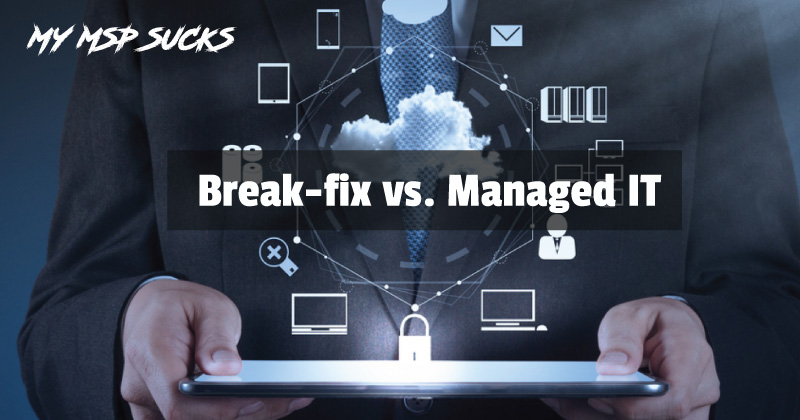Break-fix and managed IT services play essential roles in the world of IT business support. Most small- to medium-sized businesses (SMBs) are faced with picking between break/fix and managed IT. SMBs want a system that complements the IT resources and personnel they already possess.
Both managed IT and break-fix address key IT concerns such as installation, system repairs, and upgrades across software, hardware, and networking platforms. Both services resolve issues quickly and compliantly. However, there are critical differences between how managed IT services and break-fix IT services perform these functions in addition to what clients can expect when working with each.
Break Fix IT
Break-fix services provide IT support to client companies. They are generally fee-based and rely on the clients to contact the services company when needed upgrades or repairs. Break-fix service providers typically work on a time-and-material basis where they charge an hourly rate plus the cost of parts. Break-fix service providers do not commit to service-level agreements (SLA).
Pros
The break/fix model offers simplicity from the client’s perspective. With no up-front investment in IT services, the service is a pay-as-necessary model entirely. This attracts small businesses with simple IT needs, such as keeping a small number of office equipment up and running.
Implementing the break/fix model is hassle-free for IT service providers. Instead of selling, creating, and managing yearly contracts, they only need to charge technician labor rates and parts.
Cons
The problem with break-fix IT support is the lack of preventative maintenance and proactive monitoring of the clients’ IT systems. By way of explanation, the client waits for something to fail rather than taking measures to prevent it from occurring. A server failure, for example, could happen at the most inconvenient time.
Additionally, it’s not in the financial interest of the service provider to offer a quick fix for the problem. Therefore, the client may end up paying more to resolve the issue.

Managed IT
IT systems are proactively monitored with managed services, and routine maintenance is carried out as part of a standard services contract. Using the managed service model, the client is usually billed monthly or annually for the services provided, backed by SLAs. It consists of a flat monthly or annual fee, often based on the number of end-users or the endpoints under management in the client’s business.
Pros
Managed services providers (MSPs) spend less active time cleaning up messes and instead aim to prevent problems in the first place. This ensures that the service provider’s goal is better aligned with the client’s goal.
- Fixed and predictable monthly fees give clients budget clarity and aids business planning.
- MSPs provide better stability with 24/7 monitoring and proactive maintenance. They can respond to issues quickly and deflect potential system failures before damage is done.
- Managed IT systems offer infrastructure upgrades to clients. Rather than reacting to system failures, MSPs provide clients with more secure and robust IT environments by managing network performance, backup, security, helpdesk, email, and more.
- A more affordable solution than in-house IT. MSPs allow clients to access dedicated expertise at a fraction of the cost of a full-time team.
Cons
There is lower synergy between businesses and IT service providers in understanding the internal infrastructure, business, and industry needs.
As managed IT, service personnel are not physically available in the office; they are unavailable to fix urgent issues. An MSP that provides on-site services can ease this disadvantage.
Customer Focus of Managed IT
A well-established managed service provider would possess a large bench of talent with knowledge across specific subject matters. With the help of their team, you will be able to implement solutions outside a person’s scope.
Managed IT services focus on customer satisfaction and increase its ability to concentrate on its core strength and value creation process. Partnering with a great MSP allows the company to focus on activities that generate revenue.
The right managed service provider will continuously add value, particularly for small to mid-sized business clients. They allow businesses with limited resources to find better, more efficient ways to leverage what they have, consequently offering their clients more value.
Protected Harbor balances the services between break-fix and proactive maintenance. We don’t resell third-party apps or services, rather we own our equipment and create a customizable and reliable infrastructure for your business.
Which one is right for you? Well, as I’ve said at the beginning of this guide, there’s a lot to consider. Perhaps you’re interested in a cloud-based platform, which would be best for businesses that don’t have the in-house IT staff, have limited resources in general, or work with highly sensitive data that needs to be properly protected and secure. Perhaps you need a little more than break/fix offers but don’t want to invest in full-service. It all depends on your business, your budget, and what you can live with in terms of risk.




